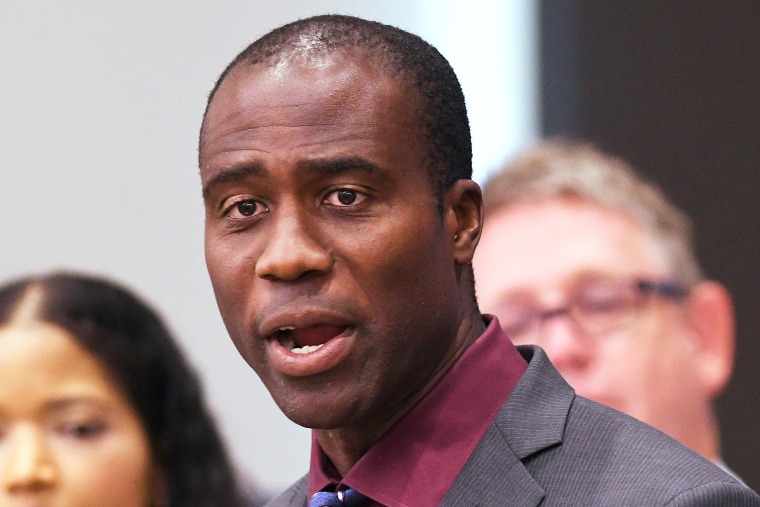The Florida measles outbreak is expanding. On Friday, health officials inBroward County confirmed a seventh case of the virus, a child under age 5.
The patient is the youngest so far to be infected in the outbreak, and the first to be identified outside of Manatee Bay Elementary School in Weston, near Fort Lauderdale.
It’s unknown what connection the youngest measles case has to the school, but the spread beyond school-age kids was expected.
Cases are “not going to stay contained just to that one school, not when a virus is this infectious,” said Dr. David Kimberlin, co-director of the division of pediatric infectious diseases at the University of Alabama at Birmingham.
The Centers for Disease Control and Prevention reported that as of Friday there have been at least 35 measles cases in 15 states in 2024 — most related to international travel. In January, there were nine measles cases in Pennsylvania, eight of them in Philadelphia. (If there are no more cases reported there as of early next week, the Philadelphia outbreak will be declared over.) Late Friday,Michigan’s health department announced that it, too, had identified a measles case — its first since 2019.
Florida’s outbreak is the largest in the U.S. right now. And what Florida’s health officials are doing — or not doing — is drawing fire from experts who study the way diseases spread.

Measles is so contagious and has such a long incubation period that the decision of the state’s Surgeon General Dr. Joseph Ladapo to let parents decide whether to quarantine their children or let them keep going to school could allow cases to spread, experts warn.
“Measles is the most infectious pathogen in humans that we know of,” said Kimberlin. “It’s like a heat-seeking missile. It will find the people who are not immune, and they’re going to get sick.”
Unvaccinated people have a 90% chance of becoming infected if exposed.
“Epidemiology 101 is identify and isolate,” said Katelyn Jetelina, who tracks illnesses for a website called “Your Local Epidemiologist.” This is especially true for outbreaks of measles, she said, because of how incredibly contagious the virus is and the fact that people who are infected can spread it for up to three weeks.
In a letter sent to parents at the elementary school on Tuesday, Ladapo wrote, “Due to the high immunity rate in the community, as well as the burden on families and educational cost of healthy children missing school, DOH is deferring to parents or guardians to make decisions about school attendance.”
The letter said that parents should watch for symptoms of measles — high fever, rash, red, watery eyes — but did not encourage vaccination.
How Ohio got measles quickly under control
When Columbus, Ohio, Health Commissioner Dr. Mysheika Roberts was confronted with a surging measles outbreak in 2022, parents in the state also got a letter, with a very different message.
Eighty-five children, mostly unvaccinated toddlers, became infected with measles in central Ohio. Nearly half, 42%, had to be hospitalized.
When the Ohio outbreak began, Roberts advised that unvaccinated children who had been exposed to measles receive one dose of the mumps-measles-rubella (MMR) vaccine as a form of “post-exposure prophylaxis,” she said.
The 21-day quarantine was reduced to just 72 hours for kids who got the shot.
Infectious disease experts told Roberts it could take six months or more to get it under control. She and her team did it in three.
“By February, we were able to declare the outbreak over,” Roberts said.
Roberts attributes that success to sticking with standard public health guidance: identify and isolate patients — and tell the public what to do.
“We were very clear with what we needed to do to try to control this outbreak,” Roberts said.
Ohio’s guidance included:
- Encouraging the MMR vaccine, which offers 97% protection against infection.
- Keeping unvaccinated kids who’d been exposed to the virus out of school, daycare and other activities for 21 days.
The letter from Columbus public health officials strongly suggested that families comply with the suggested quarantine.
“We did not leave it up to the parents,” Roberts said. “It was not an order, but the way that we wrote the letter, people probably felt like they didn’t have a choice.”
Since the 2022 outbreak, Ohio has reported only one measles case in 2023 andat least one so far in 2024.
An estimated 1 in 5 measles patients is hospitalized, according to the CDC. And one to three out of 1,000 patients will die.
In Florida, dozens of students at the elementary school are vulnerable, and some may have siblings too young to be fully vaccinated. Meanwhile, vaccine exemptions in Florida have been ticking up in recent years, according to CDC data.
During a school board meeting on Wednesday, Broward County Public Schools Superintendent Peter Licata said 33 of the 1,067 Manatee Bay Elementary students are unvaccinated.
Maria Caballero, whose daughter attends Manatee Bay, told NBC News earlier this week that she is keeping the girl out of school for now. She has twin baby boys who were born prematurely and aren’t yet old enough for the first dose of the MMR vaccine, which is given starting at age 1.
“Even though my 10-year-old is fully vaccinated, I am just concerned she will get the virus and bring it home,” said Caballero.
The Florida outbreak comes at a time when the number of national vaccine exemptions has reached an all-time high. A November CDC report found that 3% of children entering kindergarten during the 2022-2023 school year were granted a vaccine exemption from their state. This is the highest exemption rate ever reported in the U.S.
“More and more people are questioning vaccines and why people need vaccines,” said Kimberlin, the University of Alabama doctor. “They’re gonna find out pretty soon.”
Source: | This article originally belongs to Nbcnews.com









